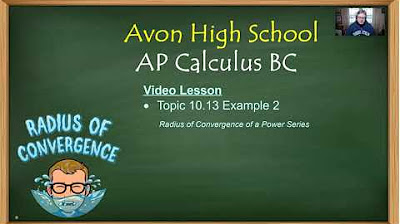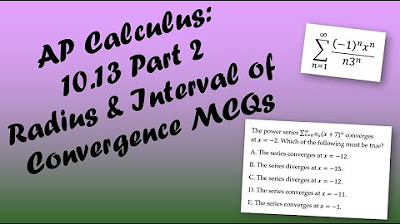AP Calculus BC Lesson 10.13 Part 1
TLDRThis video lesson delves into power series, focusing on their interval and radius of convergence. It explains the concept of a power series, highlighting how the center is determined and its relevance to Taylor or Maclaurin polynomials. The lesson progresses to illustrate how to calculate the terms of a power series and introduces the interval and radius of convergence. The ratio test is applied to find these parameters for various series, emphasizing the importance of testing endpoints due to the ratio test's inconclusiveness at limits equal to one. The video concludes with a comprehensive example, demonstrating the process of finding the radius and interval of convergence for a given power series.
Takeaways
- 📚 Power series are mathematical expressions of the form ∑ from n=0 to ∞ of a_n * (x - c)^n, where c is the center of the series.
- 🌐 The center (c) of a power series is analogous to the value plugged into a Taylor or Maclaurin polynomial.
- 🔍 Examples of power series centers include series with centers at 1, 0, and -4, depending on the value of x and the expression.
- 📈 The terms of a power series are calculated by substituting n with increasing integer values starting from 0.
- 🌟 Power series can have different centers, which affects their convergence properties.
- 📊 The interval of convergence is the range of x values for which a power series converges.
- 📏 The radius of convergence is the distance from the center to the endpoints of the interval of convergence.
- 🧪 The ratio test is a method used to determine the interval and radius of convergence for a power series.
- 🔄 The ratio test involves finding the limit as n approaches ∞ of the absolute value of a_n+1 / a_n and comparing it to 1.
- 📌 When the ratio test is inconclusive (limit equals 1), endpoints must be checked individually for convergence.
- 📝 Three possible scenarios for power series convergence are: convergence only at the center (R = 0), convergence within a range around the center (finite R), and convergence for all x values (R = ∞).
Q & A
What is a power series and how is it represented?
-A power series is a series represented in the format ∑ from n=0 to Infinity of a_sub_n * (x - c)^n, where the variable c represents the center of the series, similar to the concept of the center in a Taylor or Maclaurin polynomial.
How do you identify the center of a power series?
-The center of a power series is identified by the value that is plugged into 'x' in the expression (x - c)^n. For example, if the series is (x - 1)^n, the center is 1 because 1 is plugged into 'x'.
What are the intervals of the power series examples provided in the transcript?
-The first power series has a center of 1, the second has a center of 0, and the third has a center of -4. These centers correspond to the intervals [1, Infinity), (-Infinity, Infinity), and (-Infinity, -4) respectively.
What is the interval of convergence for a power series?
-The interval of convergence is the range of values of 'x' for which the power series converges. It is an interval containing the values of 'x' that allow the series to converge.
How is the radius of convergence determined?
-The radius of convergence is determined by the distance from the center 'c' to either end point of the interval of convergence. It is the value that defines how far the series can converge from its center 'c'.
What is the ratio test and how is it used to find the interval and radius of convergence?
-The ratio test is a method used to determine whether a series converges or diverges. It involves taking the limit as n approaches Infinity of the absolute value of the ratio of consecutive terms (a_(n+1)/a_n). If this limit is less than one, the series converges absolutely; if greater than one, it diverges; and if equal to one, the test is inconclusive.
How do you find the interval and radius of convergence for the series ∑ from n=1 to Infinity of (-1)^n * (x - 2)^n / n^2?
-Applying the ratio test, we find that the series converges for |x - 2| < 1, which gives us the interval of convergence (1, 3). The center is 2, and since the interval is from 1 to 3, the radius of convergence is 1.
What happens when the ratio test is inconclusive at the endpoints of the interval of convergence?
-When the ratio test is inconclusive (limit equals one) at the endpoints, we must test each endpoint individually by plugging the endpoint value into the original series to determine if it converges or diverges.
What are the three possible outcomes for the convergence of a power series?
-The three possible outcomes are: 1) The series converges only at the center (R equals zero), 2) The series converges for a certain range of values around the center (finite interval of convergence), and 3) The series converges for all values of 'x' (R equals Infinity).
How do you identify the center and radius in the process of solving for the interval of convergence?
-The center is identified by the value 'c' in the expression (x - c)^n. The radius is found by looking for an expression in the format |x - c| < R during the solving process. The radius represents the distance from the center to the endpoints of the interval of convergence.
What is the interval of convergence for the series ∑ from n=1 to Infinity of (x + 4)^n / 3^n?
-The interval of convergence is (-7, 1). The series diverges at x = -7 and x = 1, so the interval does not include the endpoints.
How do you determine if a power series converges at a specific point?
-To determine if a power series converges at a specific point, plug the value of that point into the original series and analyze the resulting series. If the resulting series converges, then the original series converges at that point.
Outlines
📚 Introduction to Power Series
This paragraph introduces the concept of power series, explaining their general form and the significance of the variable 'C' as the center. It provides examples of power series with different centers and outlines how to identify these centers. The paragraph also briefly touches on the connection between power series and Taylor or Maclaurin polynomials.
📈 Determining Convergence: Ratio Test
The paragraph delves into the method of finding the interval and radius of convergence for a power series using the ratio test. It explains the concept of the interval of convergence and how it contains the values of 'X' for which the series converges. The radius of convergence is defined as the distance from the center to the endpoints of the interval. The paragraph illustrates the process with a detailed example, showing how to apply the ratio test and interpret its results to find the interval and radius of convergence.
🔍 Testing Endpoints and Special Cases
This section discusses the importance of testing endpoints in the interval of convergence and presents three scenarios for power series convergence. It explains that the series always converges at its center, and endpoints must be checked individually since the ratio test is inconclusive at these points. The paragraph provides examples for each scenario, demonstrating how to handle different cases and calculate the interval and radius of convergence accordingly.
📊 Application of Ratio Test for Specific Series
The paragraph applies the ratio test to specific power series, showing the step-by-step process of finding the interval and radius of convergence. It includes the simplification of terms, evaluation of limits, and solving inequalities to determine the convergence properties. The paragraph emphasizes checking endpoints and provides a clear explanation of how to arrive at the final interval and radius for each series.
🌐 General Convergence for a Particular Series
This part examines a particular power series and uses the ratio test to determine its interval of convergence. The paragraph highlights that the series converges for all real numbers, indicating an infinite interval of convergence and an infinite radius of convergence. It explains the mathematical reasoning behind these conclusions and how the properties of the series lead to this unique outcome.
📐 Convergence at a Single Point
The final paragraph discusses a special case where a power series converges only at a single point, which is the center. It explains that in such cases, the interval of convergence is just that single point, and the radius of convergence is zero. The paragraph provides a detailed analysis of the series, showing why it converges only at the center and how to identify this unique situation.
Mindmap
Keywords
💡Power Series
💡Center
💡Interval of Convergence
💡Radius of Convergence
💡Ratio Test
💡Convergence
💡Divergence
💡Taylor Polynomials
💡Maclaurin Polynomials
💡Absolute Value
💡Factorial
Highlights
Power series are mathematical series of the form ∑ from n=0 to ∞ of a_n(x-c)^n, where c represents the center.
The center of a power series is analogous to the center in Taylor or Maclaurin polynomials.
Examples of power series are provided, each with different centers, such as 1, 0, and -4.
The terms of a power series are calculated using the formula (x - c)^n / n!, where n starts from 0.
The interval of convergence is the range of x values for which the power series converges.
The radius of convergence is the distance from the center to the endpoints of the interval of convergence.
The ratio test is used to determine the interval and radius of convergence for a power series.
If the limit of the ratio of consecutive terms is less than 1, the series converges absolutely.
If the limit of the ratio is greater than 1, the series diverges.
When the limit of the ratio equals 1, the ratio test is inconclusive, and endpoints must be checked individually.
A power series converges at its center, and the endpoints of the interval of convergence must be tested separately.
Three possible scenarios for power series convergence are: converging only at the center, converging for a range of values around the center, or converging for all values of x.
The radius of convergence can be found by looking for an expression in the format |x - c| < R during the solving process.
The example provided demonstrates how to find the radius and interval of convergence for a series with a center of 2 and a radius of 1.
Another example shows how to find the interval of convergence and radius for a series with a center of -4 and a radius of 3.
A more complex example involves a series with a center of 5 and an interval of convergence from 0 to 10, with a radius of 5.
The final example illustrates a series that converges for all real numbers, with an infinite radius of convergence, and a center at zero.
The process of finding the radius and interval of convergence for a power series involves applying the ratio test, checking endpoints, and simplifying expressions.
Transcripts
Browse More Related Video
5.0 / 5 (0 votes)
Thanks for rating:





